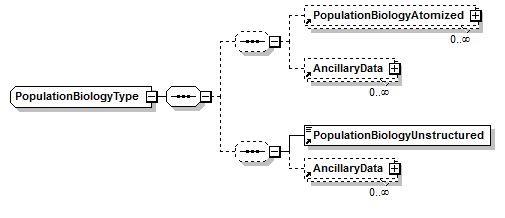-
Notifications
You must be signed in to change notification settings - Fork 6
PopulationBiologyType


Description of the variations in time and space, as well as in the size and density of populations, and the factors that cause such variations.

##Atomized branch##

PopulationBiology element in structured format.
A controlled vocabulary is recommended.
Type: [PopulationBiologyAtomizedType] (https://github.com/tdwg/PlinianCore/wiki/PopulationBiologyAtomizedType)
Ancillary information of the PopulationBiologyAtomized element.
Type: [AncillaryDataType] (https://github.com/tdwg/PlinianCore/wiki/AncillaryDataType)
##Unstructured branch##

Study of the variations in time and space as well as size and density of populations, and the factors that cause such variations. As a text block.
In Europe, the population has grown in the Alps (with the emergence of new breeding pairs due to a reintroduction project, with 19 pairs in 2010), and in the Pyrenees, particularly in its central part (Aragon, Spain), from its population of 39 pairs in 1994 to 72 pairs in 2010. In Spain, two reintroduction projects are under way in Andalusia and the Cantabrian Mountains. The total population in EU countries was estimated at 175 pairs in 2010 (J. A. Gil Gallus in litt. 2011).
Type: [NormalString] (https://github.com/tdwg/PlinianCore/wiki/NormalString)
Ancillary information of the PopulationBiologyUnstructured element.
Type: [AncillaryDataType] (https://github.com/tdwg/PlinianCore/wiki/AncillaryDataType)
| Image | Description |
|---|---|
 |
Complex Type |
 |
Sequence structure |
 |
Choice structure |
 |
Obligatory element |
 |
Optional element |
 |
minOccurs=0 maxOccurs=unbounded |
 |
minOccurs=1 maxOccurs=unbounded |